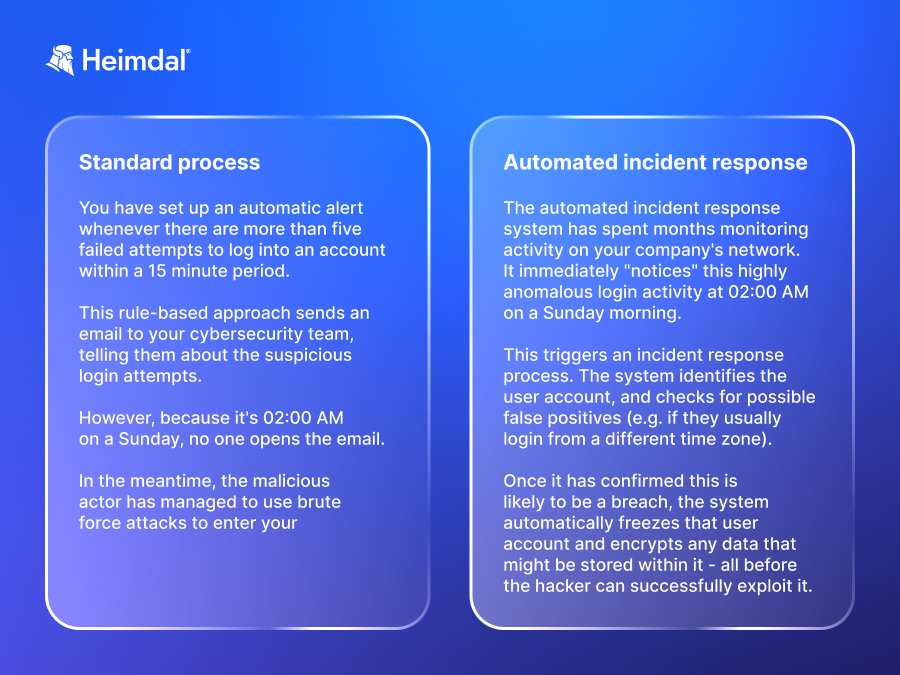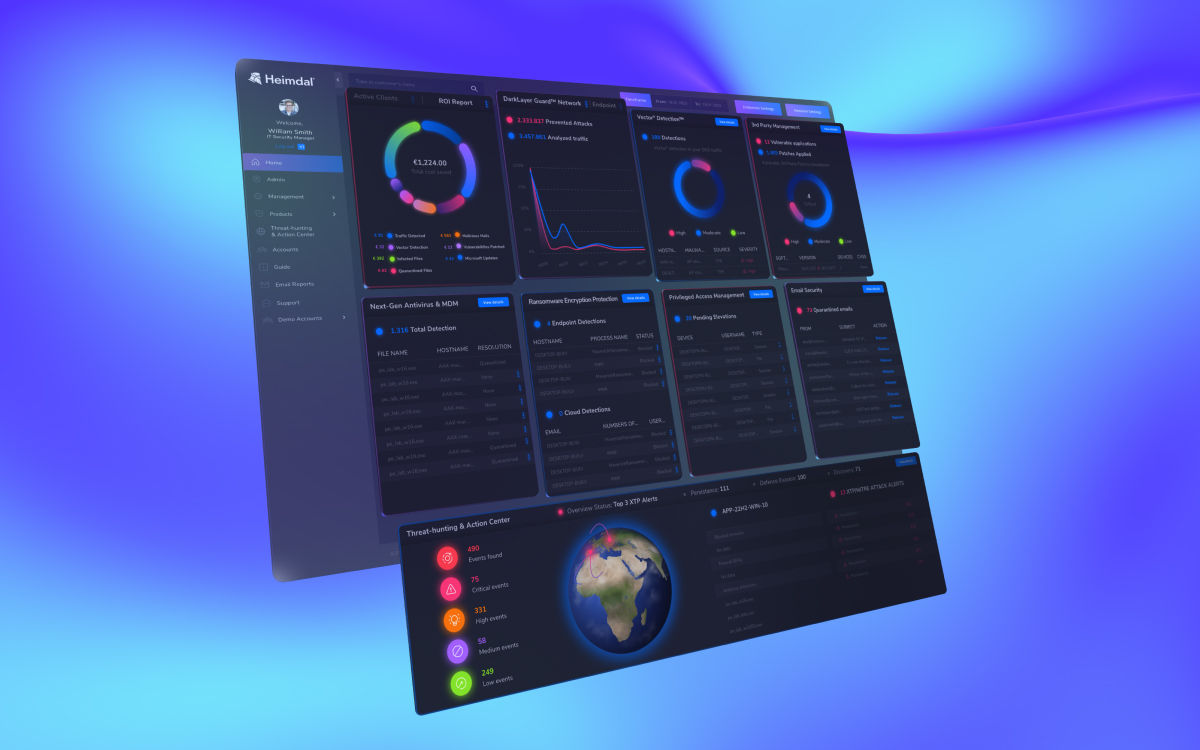Contents:
If you’re responsible for an organization’s cybersecurity, then the appeal of automated incident response is obvious. Any technology that speeds up breach response time, reduces your workload, and prevents attacks is going to tick a lot of boxes.
The concept of automated incident response isn’t entirely new. In a way, it has existed for many years – it builds on traditional rule-based incident response plans that cybersecurity teams have relied on for decades. However, the use of various forms of machine learning to enhance and improve incident detection and response is a significant step forward.
At Heimdal®, we believe automated incident response will play an increasing role in how cybersecurity teams, MSPs and SOCs detect and respond to possible threats in the coming years. Here’s everything you need to know about this emerging technology.
What Is Automated Incident Response?
Automated incident response uses AI to trigger an organization’s security breach response process when a possible attack is identified. Rather than relying on human analysts to identify breaches, investigate them and, if necessary, contain attacks, the automated system does most, or all of the process for you.
Most organizations today have fairly manual incident response processes. Incidents may be identified in various ways (rule-based alerts, staff noticing files have gone missing, employees noticing unusual activity on their accounts etc.) and these are elevated to the security team. They then investigate the issue and, if a breach is identified, follow a protocol to close the incident down.
Automated incident response mirrors this process, but uses AI to speed it up. Rather than waiting for your human security team to notice or be alerted to possible incidents, machine learning technologies continually scan your environment. If they identify any unusual behavior, they implement your incident response process and isolate infected devices, accounts or apps.
Comparing Automated Incident Response With Standard Processes
Imagine it is 02:00 AM on a Sunday morning and someone is trying to enter your company’s systems. There’s been a spike in login attempts and password recovery requests.
This is a classic signal that a cybersecurity breach may be underway, with multiple login attempts happening outside normal business hours.
The following table compares the use of automated incident response with the standard process found at many organizations to address this possible attack.
The Benefits of Automated Incident Response

Automated incident response is gaining traction within the cybersecurity community for a number of reasons. Here are some of the key benefits of automated incident response.
It Is Highly Effective
The most compelling reason to deploy automated incident response technology is that it just works.
For example, in an academic study for the International Journal of Advanced Engineering Technologies and Innovations, researchers compared an AI-powered automated incident response process with a traditional rule-based security approach. In their study, the automated approach achieved detection accuracy of 95.7% compared to 82.4% for the rule-based approach.
The AI approach was also faster (identifying threats in 12 milliseconds compared to 48 milliseconds) and generated false positives just 3.2% of the time, compared to 12.5% with the traditional approach.
24/7 Incident Response
An automated incident response process means your organization can respond to potential breaches 24 hours per day, seven days per week. Many hackers will target company systems outside of normal operating hours, precisely because security staff will be asleep and less likely to respond to threats.
An AI-powered system means security threats will continually be scanned for and responded to.
Attackers conduct reconnaissance and often strike during non-business hours
Combats Notification Fatigue
Cybersecurity teams are often overwhelmed with endless notifications about possible breaches. Using automated incident response means that more possible incidents are identified and investigated automatically, reducing the burden on staff.
Wins Back Time
A major benefit of all automation is that it wins back time. Your security employees can spend more time on more complex tasks (from analyzing emerging threats through to training other staff on security best practice), rather than carrying out relatively tedious and repetitive investigations into possible breaches.
The reporting of a security incident to the stakeholders – IT crew, Management, Communication and PR, etc. should be immediate. Quick action is crucial in mitigating risks and limiting potential damage
Learn more: How to build a cyber incident response team
Challenges And Considerations Around Automated Incident Response
Although automated incident response is a significant improvement on traditional incident response, it can introduce challenges too.
- ‘Black box’ phenomenon: Some cybersecurity solutions are a ‘black box’ – it’s difficult or impossible to understand why the underlying AI has made certain decisions about what incidents to respond to and why.
- Sensitivity: Automated incident response may be overly sensitive, or not sensitive enough. It’s vital to regularly review and adjust parameters so the system can ‘learn’.
- Complacency: Sometimes, using automated incident response technology can breed complacency. While the technology is good, it is still essential for skilled staff to verify the machine’s actions and monitor activity too.
How to Implement Automated Incident Response
Automated incident response uses a number of AI technologies to help organizations monitor their environments and respond to risks. Different solutions work in different ways, but the implementation process is fairly universal:
- Deploy: You deploy the automated incident response solution to your network, and it scans for all connected accounts, devices and apps.
- Monitor: The system uses machine learning to understand what ‘normal’ looks like for your organization.
- Incident response: You define exactly how the system should respond to incidents. For some organizations, this can be about checking false positives and alerting IT. For others, it can be about automatically freezing accounts and isolating threats.
- Creating a record: Automated incident response may also create an auditable log that shows exactly what happened to show why the AI system decided to implement certain actions.
- Post incident analysis and improvement: These technologies use machine learning and human direction to improve over time. For example, if the technology identified a single file download as suspicious – even when it was perfectly legitimate – you should be able to train the system to avoid making this mistake again.
Tools and Technologies for Automated Incident Response
Automated incident response is an emerging field. That said, there are a number of companies offering solutions in this area.
Heimdal® XDR

Heimdal®’s Extended Detection & Response solution uses real time, automatic threat hunting, bilateral telemetry, MITRE ATT&CK techniques and automated remediation and response to manage potential threats quickly and efficiently.
Microsoft Defender XDR
A good choice for any company that primarily uses Windows, the Microsoft Defender XDR automatically investigates and responds to a wide range of breaches on Windows 11 and Windows 10 devices.
Resolve AITSM
Rezolve AI uses generative AI to allow organizations to build their own automated IT service desk which can carry out automated incident detection and response.
Related: The 12 Best Incident Response Software On the Market
Ready to Begin Using Automated Incident Response?
Heimdal® XDR features live alerting and detection for high-risk triggers. So, as soon as a potential threat is identified, both the customer and our team are notified in real-time or near real-time.
The benefits of automated incident response for SOC’s, cybersecurity analysts and MSPs are clear and speak for themselves. There is no doubt that automating incident detection and response does require a step change in how you work. But with effective support and reliable, transparent and easy-to-use solutions, your organization can experience major boosts in productivity and security.
Automated Incident Response FAQs
We’ve answered your most common questions about automated incident response.
Can I trust automated incident response to identify threats correctly?
Many organizations are understandably cautious about handing over threat detection and response to AI. However, Heimdal®’s automated incident response solution is tested thousands of times daily and continually managed by our highly experienced MXDR team. We continually feed it with the latest threat intelligence, improve AI/ML predictive models and conduct detailed attack analysis.
What about the risk of automated incident response being a ‘black box’?
It is true that some automated incident response solutions operate like a ‘black box’ where you cannot understand how or why the underlying AI has made certain ‘decisions’. However, Heimdal®’s XDR solution provides a transparent report of all threats it identifies, with clear and auditable data for you to learn more.
Will automated incident response make cybersecurity staff redundant?
No, not at all. Most cybersecurity teams are overworked and under-resourced. Automation frees up employees’ time by speeding up the threat investigation process, identifying false positives, and winning them back time to focus on more complex, challenging or human to human tasks (such as training).










 Network Security
Network Security
 Vulnerability Management
Vulnerability Management
 Privileged Access Management
Privileged Access Management  Endpoint Security
Endpoint Security
 Threat Hunting
Threat Hunting
 Unified Endpoint Management
Unified Endpoint Management
 Email & Collaboration Security
Email & Collaboration Security











